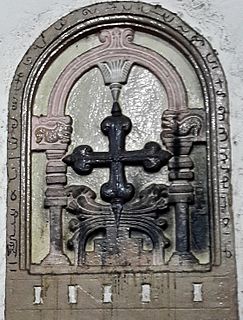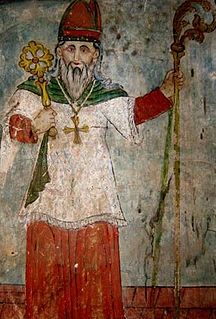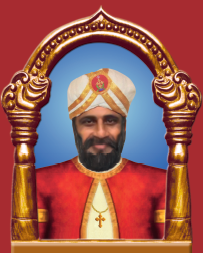Related Research Articles
The Saint Thomas Christians, also called Syrian Christians of India, Marthoma Suriyani Nasrani, Malankara Nasrani, or Nasrani Mappila, are an ethno-religious community of Indian Christians in the state of Kerala, who currently employ the East Syriac and West Syriac liturgical rites of Syriac Christianity. They trace their origins to the evangelistic activity of Thomas the Apostle in the 1st century. The Saint Thomas Christians had been historically a part of the hierarchy of the Church of the East but are now divided into several different Eastern Catholic, Oriental Orthodox, Protestant, and independent bodies, each with their own liturgies and traditions. They are Malayalis and speak Malayalam. Nasrani or Nazarene is a Syriac term for Christians, who were among the first converts to Christianity in the Near East.

The Syro-Malabar Catholic Church is an Eastern Catholic church based in Kerala, India. The Syro-Malabar Church is an autonomous particular church in full communion with the pope and the worldwide Catholic Church, including the Latin Church and the 22 other Eastern Catholic Churches, with self-governance under the Code of Canons of the Eastern Churches (CCEO). The Church is headed by the Metropolitan and Gate of all India Major Archbishop Mar George Cardinal Alencherry. The Syro-Malabar Synod of Bishops canonically convoked and presided over by the Major Archbishop constitutes the supreme authority of the Church. The Major Archiepiscopal Curia of the Church is based in Kakkanad, Kochi. Syro-Malabar is a prefix coined from the words Syriac as the church employs the East Syriac Rite liturgy, and Malabar which is the historical name for modern Kerala. The name has been in usage in official Vatican documents since the nineteenth century. It is the second largest Eastern Catholic Church in the Catholic communion, after the Ukrainian Greek Catholic Church. The Syro-Malabar Church is primarily based in India; with 5 metropolitan archeparchies and 10 suffragan eparchies in Kerala, there are 17 eparchies in other parts of India, and 4 eparchies outside India.

The Synod of Diamper , held at Udayamperoor in June 1599, was a diocesan synod, or council, that created rules and regulations for the ancient Saint Thomas Christians of the Malabar Coast, a part of modern-day Kerala state, India, formally subjugating them and downgrading their whole Metropolitanate of India as the diocese of Angamale, a suffragan see to the Archdiocese of Goa administered by Roman Catholic Padroado missionaries. This synod also introduced many Latin practices in the liturgy of the Saint Thomas Christians which they had been following from centuries. The forced Latinization and disregard for the eastern and local tradition led to a massive protest by Saint Thomas Christians known as Coonan Cross Oath and subsequent schism among them the by mid-17th century.

The Coonan Cross Oath, also known as the Great Oath of Bent Cross, the Leaning Cross Oath or the Oath of the Slanting Cross, taken on 3 January 1653 in Mattancherry, was a public avowal by members of the Saint Thomas Christians of the Malabar region in India, that they would not submit to the Jesuits and Latin Catholic hierarchy, nor accept Portuguese dominance in ecclesiastical and secular life. There are various versions about the wording of oath, one version being that the oath was directed against the Portuguese, another that it was directed against Jesuits, yet another version that it was directed against the authority of Church of Rome

Mar Thoma I, also known as Valiya Mar Thoma and Arkkadiyokkon Thoma in Malayalam and Thomas de Campo in Portuguese was the first native-born, popularly-selected Metropolitan bishop of the Puthenkoor faction of the Saint Thomas Christians or Saint Thomas Christians. He was the last Archdeacon of the undivided St. Thomas Christians of Malankara (Maliyankara).

Thachil Mar Matthoo Tharakan (1741–1814) was a Saint Thomas Christian merchant, social leader and minister who played a key role in Kerala, especially in its Travancore and Cochin regions, in India towards the latter part of the 18th century and early 19th century. He relentlessly worked to bring about a reunification in his community which was divided into Catholic (Pazhayakūr) and Jacobite (Puthenkūr) after the Coonan Cross Oath of 1653. He organized his community against the colonialist attempts of Portuguese and played a prominent role in the assembly of Catholic Saint Thomas Christians at Angamāly that paved the way for the establishment of independent Syro-Malabar hierarchy.

This is a timeline of the history of the Syro-Malabar Catholic Church in India.

The Malankara Church, also known as Puthenkur and more popularly as Jacobite Syrians, refers to the collection of West Syriac Saint Thomas Christian denominations, which claim ultimate apostolic origins from the missions of Thomas the Apostle according to tradition. The community under the leadership of Thoma I, that resisted the Padroado Jesuits as well as the Propaganda Carmelites of the Roman Catholic Church, following the historical Coonan Cross Oath of 1653. In 1665, Gregorios Abdul Jaleel, sent from Patriarch Ignatius Abdulmasih I introduced West Syriac Rite in India. By 1809, the Jacobite Syrians fully incorporated the Antiochian Syriac Rite liturgy after the assembly of parish representatives met at Kandanad, Kerala and resolved to fully implement the move to West Syriac Rite through the declaration Kandanad Padiyola, which had been already partially implemented by the same assembly in 1789 at Puthiyacavu. The modern-day descendants of the Jacobite Syrians are the Jacobite Syrian Christian Church (JSCC), the Malankara Orthodox Syrian Church (MOSC), the Malankara Marthoma Syrian Church (MTC), the Syro-Malankara Catholic Church and the Malabar Independent Syrian Church. Among these, only the JSCC form an integral part of the Syriac Orthodox Church of Antioch. The autocephalous MOSC, also known as the Indian Orthodox Church is one of the member churches of Oriental Orthodox communion. The MTC is an independent Oriental Protestant church that is in communion with the Church of England and its Anglican communion. The Syro-Malankara Catholic Church is an autonomus sui iuris Eastern Catholic particular church, in full communion with the Holy See and the worldwide Catholic Church, with self-governance under the Code of Canons of the Eastern Churches.

Paremmakkal Thoma Kathanar (1736–1799) is the author of Varthamanappusthakam (1790), the first ever travelogue in an Indian language. Also known as Roma Yatraa Varthamanapusthakam, it postulates that the foundation of Indian nationalism rests on the basic principle that India should achieve civic self-rule. Long before the debates on nationalism shaking the intellectual circles of Europe, Asia, and Africa, Thoma Kathanar offers a distinctive positionality as a minority Syriac Christian priest and subsequent administrator of the Archdiocese of Cranganore with transnational ties to Portuguese ecclesiology who nevertheless argues in favor of autonomous civic Indian governance.

Kariattil Mar Iousep, alternatively written as Mar Joseph Kariattil, was the first native Indian to be appointed as Metropolitan of Kodungalloor (Cranganore) for Syrian Catholics in the territory now comprising Kerala, India.

Palliveettil Chandy also known as Parambil Chandy was a bishop of the Catholic Saint Thomas Christians. He is also the first known native Indian bishop. He was the bishop of the East Syriac Rite (Chaldaean) faction after the Coonan Cross Oath in 1653. This faction returned to full communion with the Holy See of Rome, it would later become known as the modern-day Eastern Catholic Syro-Malabar Church. Mar Chandy's tomb is at the Marth Mariam Major Archiepiscopal Church at Kuravilangad.
The Syro-Antiochian Rite in Malabar is the form of the Syro-Antiochian liturgical rite practiced by several churches of the Saint Thomas Christian community in Kerala, India. West Syriac liturgy was brought to India by the Syriac Orthodox Bishop of Jerusalem, Gregorios Abdal Jaleel, in 1665; in the following decades the Malankara Rite emerged as the liturgy of the Malankara Church, one of the two churches that evolved from the split in the Saint Thomas Christian community in the 17th century. Today it is practiced by the various churches that descend from the Malankara Church, namely the Malankara Mar Thoma Syrian Church, Malankara Orthodox Syrian Church, the Jacobite Syrian Christian Church, the Syro-Malankara Catholic Church and the Malabar Independent Syrian Church

St. Thomas Cathedral is the Syro Malabar Catholic cathedral of the eparchy of Irinjalakuda in India got its present existence under the nomenclature and the Canonical Status as Cathedral in the Wake of the Origin of the New Eparchy. This was effected by the amalgamation of the two independent and important parishes of the locality, namely, St. George’s Forane Church and St. Mary’s church, which amicably situated side by side for about a century.

The Saint Thomas Christian denominations are traditional Christian denominations from Kerala, India, who trace their origins to the evangelistic activity of Thomas the Apostle in the 1st century. They are also known as "Nasranis" as well. The Syriac term "Nasrani" is still used by St. Thomas Christians in Kerala.

The Eparchy (Diocese) of Palai is a Syro-Malabar Catholic eparchy with an area of 1166 km2 comprising the Meenachil taluk and a few villages of the neighbouring taluks in Kottayam, Ernakulam, and Idukki districts of central Kerala in South India. The faithful of this eparchy, numbering 326,742, belong to the ancient St. Thomas Christian community. The seat of the bishop is the St. Thomas Cathedral based in the town of Palai. The current bishop is Mar Joseph Kallarangatt, serving since March 2004. Mar Jacob Muricken has been auxiliary bishop since 2012.
Kottakkavu Mar Thoma Syro-Malabar Pilgrim Church is a Syro-Malabar church located in North Paravur. According to Saint Thomas Christian tradition, the church was established in 52 AD by St. Thomas, one of the twelve apostles of Jesus Christ. It is one of the first churches in India and is called an Apostolic Church credited to the Apostolate of St. Thomas who preached and also started conversion of people to Syriac Christianity here. It is one of the Ezharappallikal that he established in India; the other six churches were established at Kodungalloor, Kokkamangalam, Palayoor, Kollam, Niranam, and Nilackal.

The Roman Catholic Archdiocese of Cranganore or Cranganor and Angamaly was a latinised Syriac Padroado Archdiocese in Kodungallur, Kerala, India. This diocese is a product of so-called Synod of Diamper held in East Syriac Archdiocese of Angamaly and All India. Its headquarters was first at St. Thomas church, Cranganore Fort until 1662 and then at Puthenchira church for more than a century. Mar Paremmakkal Thoma Kathanar, Administrator of the diocese moved its headquarters to Ramapuram. Mar Poulose Pandari, a Chaldean Bishop belongs to Puthenchira parish of this diocese.
Angamāly Padiyōla is a historic declaration of the Catholic (Paḻayakūṟ) Saint Thomas Christians proclaimed in 1787 at the Great Church of Saint George in Angamāly. This document made a strong appeal to the pope for the consecration of a native bishop for the community and demanded autonomy for their Church which was forcibly brought under the Latin Church's jurisdiction.

The Malankara Church Paḻayakūṟ or Pazhayakoor refers to the East Syriac denominations of the Saint Thomas Christian Church, which claim ultimate apostolic origin from the Indian mission of Thomas the Apostle in the 1st century AD. The Paḻayakūṟ descends from the faction that remained within the Catholic fold and held fast to an East Syriac identity after the historic Coonan Cross Oath of 1653 while being part of the community seceded from the Portuguese Padroado. The modern descendants of the Paḻayakūṟ Malankara Church are the Syro-Malabar Church and the Chaldean Syrian Church. Among these, the former is an Eastern Catholic Church in full Communion with the Holy See and the latter is an integral part of the Assyrian Church of the East, one of the traditionalist descendants of the Church of the East.
References
- ↑ Literary Tradition. keralahistory.ac.in. Archived 2010-08-01 at the Wayback Machine . www.keralahistory.ac.in. Retrieved on 2013-07-28.
- ↑ "Varthamana Pusthakam". keralatourism.org. Retrieved 3 April 2022.
- ↑ Menon, A. Sreedhara (2008). The legacy of Kerala (1st DCB ed.). Kottayam, Kerala: D C Books. ISBN 9788126421572.
- 1 2 www.dcbooks.com (1 June 2021). "Varthamanappusthakam- The First ever travelogue written in Indian Language" . Retrieved 3 April 2022.
- ↑ "Nazrani History and Discourse on Early Nationalism in Varthamanapusthakam". 27 January 2013.
- ↑ "Varthamanappusthakam". Archived from the original on 27 April 2013. Retrieved 10 May 2013.
- ↑ Kottyam
- ↑ "Museum". The Syro-Malabar Church. Archived from the original on 29 October 2007. Retrieved 28 September 2013.
- ↑ Bag, Ahana (18 February 2022). "Varthamanappusthakam: More Than The First Travelogue". madrascourier.com. Retrieved 3 April 2022.
- ↑ Das, Sisir Kumar. History of Indian Literature: 1911–1956, struggle for freedom : triumph and tragedy. p. 253. ISBN 9788172017989.
- ↑ "When a Keralite priest wrote India's first modern international travelogue". OnManorama. Retrieved 6 April 2022.
- ↑ "Paremmakkal Thoma Kathanar". The Syro-Malabar Church. Retrieved 28 September 2013.
